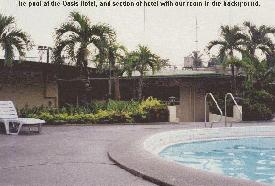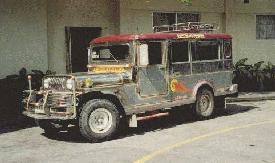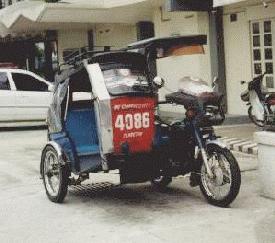Angeles City
Arlyn lived in Porac, a suburb of Angeles City which is about 50 miles north west from the centre of Manila. Mount Pinatubo, which erupted in 1991 and destroyed parts of the city, is only 15 miles to the west. Former USA Clark Air Base is also located on the outskirts of Angeles, between the city and the mountain. We stayed in what we were told was one of the best hotels in the city, the Oasis
Hotel.  I had reserved a room there two months earlier over the Internet. It was very nice and the staff was very friendly and helpful. Room rates and meals were inflated about double local Filipino standards but were much less than 1/2 the cost we'd expect to pay for similar rooms and meals in Canada. The hotel is geared to western tourists and upscale Filipinos but interestingly we had to special-order most Filipino dishes because they did not appear on the restaurant menu. The Filipino dishes were great and the staff took great pleasure in preparing them specially for us since most of the tourists, which are usually Americans, do not try the local food.
I had reserved a room there two months earlier over the Internet. It was very nice and the staff was very friendly and helpful. Room rates and meals were inflated about double local Filipino standards but were much less than 1/2 the cost we'd expect to pay for similar rooms and meals in Canada. The hotel is geared to western tourists and upscale Filipinos but interestingly we had to special-order most Filipino dishes because they did not appear on the restaurant menu. The Filipino dishes were great and the staff took great pleasure in preparing them specially for us since most of the tourists, which are usually Americans, do not try the local food.
Our room was air conditioned which saved me. The weather was very warm to hot and humid with a maximum daily temperature of 28 to 32 and a minimum nighttime temperature of 25 to 28 Deg. C. It was their rainy season which meant it rained for an hour or two virtually every day except when a typhoon or tropical depression passed nearby and then it would rain non-stop for 3-4 days. While I was there I did not experience much wind even when Typhoon Tina passed nearby the islands. Typically the power would go out for a few minutes to a few hours each day and when it was on the cable TV would go out for periods of time each day.
Arlyn could get only 6 days in a row off from work while I was there so we stayed around the city for the entire time. I did not want to tour the scenic areas on my own if Arlyn could not be with me so I was perfectly content to sit by or in the pool and read or watch movies on HBO while I waited for her to come home from work. On her days off we visited family and friends and spent lots of time alone together getting to know each other. As our wedding date approached we visited our sponsors and shopped for material for Arlyn's wedding dress and my "barong" (a formal long-sleeved shirt worn outside the slacks) and our diamond engagement and wedding rings.
Travelling Around Angeles
I had planned to rent a car for getting around and even got an international drivers license before I left Vancouver. But once I saw the traffic, I decided there was no way that I would drive. In the city of 250,000 there was not even one traffic light, except for one or two I noticed on the edge of the city. Traffic was very congested, bumper to bumper on the main streets. They drove all over the roads totally ignoring the painted driving lanes, when there were ones, often driving on the wrong side of the road against oncoming traffic, passing on the wrong side of the road with wheels up on the sidewalk, constantly honking their horns for no apparent reason, and dodging pedestrians who are crossing the streets everywhere. Apparently there are very few traffic accidents and surprisingly I did not see even one while I was there. All vehicles including cars, trucks, buses, jeepneys, and motor cycles belched black smoke and the pollution hurt my eyes.

Very few people can afford cars there, so we got around by catching "jeepneys". There are no transit buses as we know them in Angeles. Depending on size, jeepneys hold 10 to 20 people jammed in the back like sardines on two long benches facing each other. You enter a jeepney through the rear doorway (there usually is no door)and you must bend over at the waist to avoid bumping your head on the roof. I bumped my head every time I rode a jeepney. Gauges on the dashboards were minimal, a speedometer, an oil pressure gauge, and a fuel gauge. Usually none of the gauges worked at all. The drivers followed designated routes, for the most part, but there appeared to be no set stops. People seemed to get on or off wherever they wanted and after letting one person off, the driver often stopped 50 yards down the street again to let someone else on or off. For 2 pesos (10 cents) you could travel from one end of the route to the other. We also hired jeepneys to take us to specific locations a few times and this would cost more, 200 pesos or so.

When jeepneys didn't go where we wanted, we'd catch a tricycle, a motorcycle with a two-person side car. You could often see 3 or 4 people together with the driver crammed onto a trike. Once I saw a youngster riding on the roof of one.

Where tricycles didn't go we'd catch a pedicab, a 3-wheeled modified bicycle with a double-wide seat in the back for passengers. Arlyn found it particularly humorous to see me in a pedicab and to think about what my family back home would say if they could see us. She laughed all the way to her uncle's place in the bario.
I also saw many horse-drawn, 2-wheeled calesas (carts) in the centre of the city but never did ride in one.
Travelling across the city on these various modes of transportation could be surprisingly efficient, however when traffic was particularly heavy it was quite an ordeal. The traffic congestion, lack of controlled intersections, and the need to transfer 3 or 4 times between jeepneys and to tricycles or pedicabs could make just
going to visit Mom and an uncle or two a day-long adventure. In spite of the pollution, it was a fantastic and thoroughly enjoyable experience, one I'll never forget.